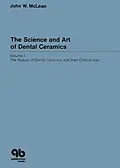There is a no more rewarding experience in restorative dentistry than to duplicate to perfection the colour, texture and surface anatomy of the human tooth. Dental porcelain is the closest match to tooth enamel of all our restorative materials but is perhaps the most difficult to use in dental practice.
A study of the science of dental porcelain will enable the dentist or technician to perfect his art since it develops an increasing awareness of the fundamental problems in construction.
Preparation design, the stresses developing in porcelain restorations, the influence of opaque backgrounds on colour, surface reflectivity and light transmission in crowns are some of the complex factors that influence the success of a porcelain veneer restoration.
A survey of metals, bonding systems, cements and impression materials will enable the clinician to select his materials with greater confidence. New research on the shoulder preparation for the veneer crown also sheds light on the controversy of the bevel versus the butt joint. The author has attempted to rationalise the use of both metal and alumina reinforced ceramics and to show how no ingle system can be applied universally if optimum aesthetics is to be achieved.
Inhalt
Monograph I: The Nature of Dental CeramicsThe Nature of GlassesCondensation of Dental PorcelainReferencesMonograph II: The Strengthening of Dental PorcelainMechanical TestingMethods of Strengthening Dental PorcelainEnamelling of MetalsTypes of Metal-Ceramic SystemsGold-Platinum-Palladium AlloysGold Bonding AgentsAlternative Alloy SystemsNature of the Porcelains used in Metal-Ceramic SystemsThe Nature of the Metal-Ceramic BondTechnical ConsiderationsBase Metal Alloy/Porcelain SystemsTypes of Metal/ Porcelain FailureTechnical Considerations-Base-Metal Alloy SystemsEvaluation of Metal-Ceramic SystemsBonding of Porcelain to Precious Metals Using Tin Oxide CoatingsDispersion Strengthening of GlassesTypes of Glass used with AluminaAluminous PorcelainInfluence of Alumina Crystal Concentration on StrengthEffect of Sintering Time on the Strength of Aluminous PorcelainDispersion Strengthening of Glass with Alumina WhiskersEnamelling of High Strength Crystalline CeramicsControlled Crystallisation of GlassesTechnical ConsiderationsReferencesMonograph III: Aesthetics of Dental PorcelainThe Nature of LightOptical PropertiesReflectionUltra-Violet Radiation and FluorescenceColour Production in Natural TeethTypes of Porcelain CrownsThe Role of Opaque Porcelains in Obtaining AestheticsRequirements for a Tooth Shade GuideShade MatchingDetermining HueDetermining ChromaDetermining ValueDetermining Metameric EffectsBlending of ColoursThe Influence of Tooth Contour on AestheticsReproducing Tooth Anatomy in Dental PorcelainFull Mouth ReconstructionReferncesSelected ReadingMonograph IV: Porcelain as a Restorative MaterialOcclusion and Dental PorcelainIndications for Use of Porcelain Jacket CrownsContra-Indications for Use of the Porcelain Jacket CrownIndications for use of the Metal-Ceramic CrownContra-Indications for use of the Metal-Ceramic CrownAluminous Porcelain Compared with Metal-CeramicsThe Platinum bonded Alumina CrownClinical CasesThe Complete Porcelain Veneer Crown and the Platinum Bonded Alumina CrownThe Devitalised ToothThe PreparationDesign FactorsStress Analysis and Design FactorsThe Bonded Alumina Crown and the Complete Porcelain Veneer Crown or Aluminous Porcelain CrownThe Atypical PreparationThe Typical Maxillary Central Incisor PreparationThe PreparationMonitoring the Depth of the Preparation by Using a Temporary Crown as a Master TemplateConstruction of an Epimine Resin Temporary CrownCommon causes of Fracture in Porcelain Jacket CrownsThe Metal-Ceramic Veneer CrownThe Labial ShoulderThe shoulder and Chamfer PreparationThe Approximal and Lingual ShouldersRecommended Designs for the Preparation and Metal Coping in Metal-Ceramic CrownsThe Metal-Ceramic CrownImproving Retention of Metal-Ceramic CrownsThe ImpressionThe Elastic ImpressionProcedures for taking Polysulphide or Polyether Elastomeric ImpressionsSteel scalpel and electrosurgical cutting on gingival tissues and alveolar boneImpression TechniqueCommon Causes of Failure in Elastomeric Impression MaterialsCementation of Porcelain and Metal-Ceramic CrownsReferencesAppendix
